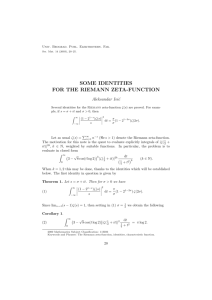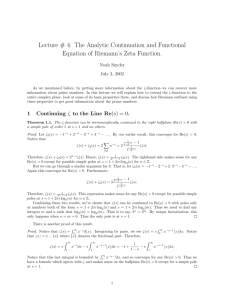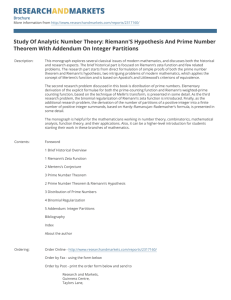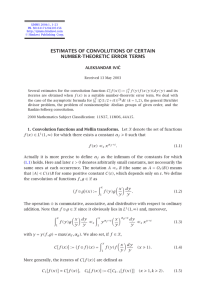Some Identities for the Riemann Zeta-Function II
advertisement
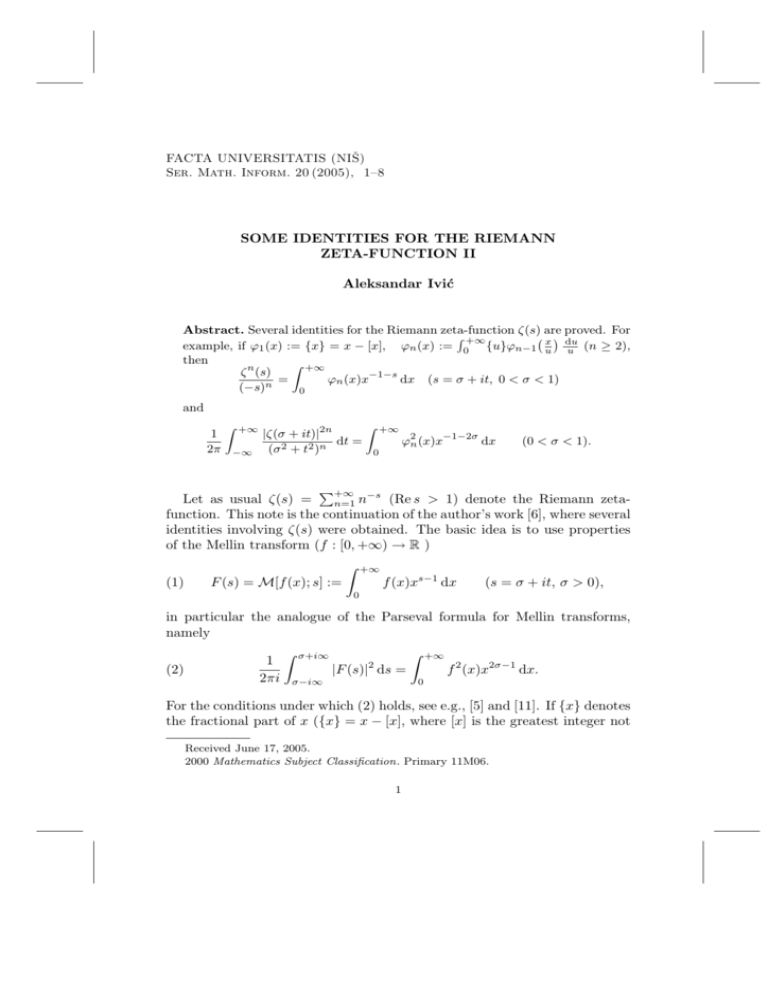
FACTA UNIVERSITATIS (NIŠ)
Ser. Math. Inform. 20 (2005), 1–8
SOME IDENTITIES FOR THE RIEMANN
ZETA-FUNCTION II
Aleksandar Ivić
Abstract. Several identities for the Riemann zeta-function ζ(s) are proved. For
¡ x ¢ du
R +∞
example, if ϕ1 (x) := {x} = x − [x], ϕn (x) := 0 {u}ϕn−1 u
u (n ≥ 2),
then
Z
+∞
ζ n (s)
=
ϕn (x)x−1−s dx (s = σ + it, 0 < σ < 1)
(−s)n
0
and
1
2π
Z
+∞
−∞
|ζ(σ + it)|2n
dt =
(σ 2 + t2 )n
Z
+∞
0
ϕ2n (x)x−1−2σ dx
(0 < σ < 1).
P+∞ −s
(Re s > 1) denote the Riemann zetaLet as usual ζ(s) =
n=1 n
function. This note is the continuation of the author’s work [6], where several
identities involving ζ(s) were obtained. The basic idea is to use properties
of the Mellin transform (f : [0, +∞) → R )
Z
(1)
F (s) = M[f (x); s] :=
+∞
f (x)xs−1 dx
(s = σ + it, σ > 0),
0
in particular the analogue of the Parseval formula for Mellin transforms,
namely
Z σ+i∞
Z +∞
1
2
(2)
|F (s)| ds =
f 2 (x)x2σ−1 dx.
2πi σ−i∞
0
For the conditions under which (2) holds, see e.g., [5] and [11]. If {x} denotes
the fractional part of x ({x} = x − [x], where [x] is the greatest integer not
Received June 17, 2005.
2000 Mathematics Subject Classification. Primary 11M06.
1
A. Ivić
2
exceeding x), we have the classical formula (see e.g., eq. (2.1.5) of E.C.
Titchmarsh [12])
(3)
ζ(s)
=−
s
Z
Z
+∞
−1−s
{x}x
+∞
dx = −
0
{1/x}xs−1 dx,
0
where s = σ + it, 0 < σ < 1. A quick proof is as follows. We have
Z
+∞
ζ(s) =
Z
x−s d[x] = s
1−0
Z +∞
=s
+∞
[x]x−s−1 dx
1
Z
+∞
([x] − x)x−s−1 dx + s
1
x−s dx
1
Z
+∞
= −s
1
s
.
{x}x−s−1 dx +
s−1
This holds initially for σ > 1, but since the last integral is absolutely convergent for σ > 0, it holds in this region as well by analytic continuation.
Since
Z 1
Z 1
s
−s−1
s
{x}x
dx = s
x−s dx =
(0 < σ < 1),
1−s
0
0
we obtain (3) on combining the preceding two formulae. We note that (3)
is a special case of the so-called Müntz’s formula (with f (x) = χ[0,1] (x), the
characteristic function of the unit interval)
Z
(4)
ζ(s)F (s) =
+∞
P f (x) · xs−1 dx,
0
where the Müntz operator P is the linear operator defined formally on functions f : [0, +∞) → C by
(5)
P f (x) :=
+∞
X
n=1
f (nx) −
1
x
Z
+∞
f (t) dt.
0
Besides the original proof of (4) by Müntz [8], proofs are given by E.C.
Titchmarsh [12, Chapter 1, Section 2.11] and recently by L. Báez-Duarte
[2]. The identity (4) is valid for 0 < σ < 1 if f 0 (x) is continuous, bounded
in any finite interval and is O(x−β ) for x → ∞ where β > 1 is a constant.
The identity (3), which Báez-Duarte [2] calls the proto-Müntz identity, plays
an important rôle in the approach to the Riemann Hypothesis (RH, that
Some Identities for the Riemann Zeta-function II
3
all complex zeros of ζ(s) have real parts equal to 1/2) via methods from
functional analysis (see e.g., the works [1]–[4] and [9]).
Our first aim is to generalize (3). We introduce the convolution functions
ϕn (x) by
Z +∞
¡ x ¢ du
{u}ϕn−1
(6) ϕ1 (x) := {x} = x − [x], ϕn (x) :=
(n ≥ 2).
u u
0
The asymptotic behaviour of the function ϕn (x) is contained in
Theorem 1. If n ≥ 2 is a fixed integer, then
³
´
x
(7) ϕn (x) =
logn−1 (1/x) + O x logn−2 (1/x)
(n − 1)!
(0 < x < 1),
and
(8)
ϕn (x) = O(logn−1 (x + 1))
(x ≥ 1).
Proof. Using the properties of {x}, namely {x} = x for 0 < x < 1 and
{x} ≤ x, one easily verifies (7) and (8) when n = 2. To prove the general
case we use induction, supposing that the theorem is true for some n. Then,
when 0 < x < 1,
Z x Z 1 Z +∞
ϕn+1 (x) =
+
+
= I1 + I2 + I3 ,
0
x
1
say. We have, by change of variable,
Z x
Z +∞
³ x ´ du Z x
³x´
dv
I1 =
{u}ϕn
=
ϕn
du = x
ϕn (v) 2 = O(x).
u
u
u
v
0
0
1
By the induction hypothesis
Z 1
³ x ´ du Z 1
³x´
I2 =
{u}ϕn
=
ϕn
du
u u
u
x
x
Z 1½
³ ´
³x
³ ´´¾
x
n−1 u
n−2 u
=
log
+O
log
du
(n − 1)!u
x
u
x
x
Z 1/x
³
´
x
dy
=
logn−1 y
+ O x logn−1 (1/x)
(n − 1)! 1
y
x
logn (1/x) + O(x logn−1 (1/x)).
=
n!
A. Ivić
4
Finally, since {x} ≤ x and (8) holds,
µ ¶
Z +∞
Z +∞
³ x ´ du
³ ´ du
1
n−1 u
n−1
I3 =
{u}ϕn
¿x
log
¿ x log
.
2
u u
x u
x
1
1
The proof of (8) is on similar lines, when we write
Z 1 Z x Z +∞
ϕn+1 (x) =
+
+
= J1 + J2 + J3
0
1
(x ≥ 1),
x
say, so that there is no need to repeat the details. By more elaborate analysis
(7) could be further sharpened. ¤
Theorem 2. If n ≥ 1 is a fixed integer, and s = σ + it, 0 < σ < 1, then
Z +∞
ζ n (s)
(9)
=
ϕn (x)x−1−s dx.
(−s)n
0
Clearly (9) reduces to (3) when n = 1. From Theorem 1 it transpires that
the integral in (9) is absolutely convergent for 0 < σ < 1. By using (2) (with
−s in place of s) we obtain the following
Corollary 1. For n ∈ N we have
Z +∞
Z +∞
1
|ζ(σ + it)|2n
(10)
dt =
ϕ2n (x)x−1−2σ dx
2π −∞ (σ 2 + t2 )n
0
(0 < σ < 1).
Proof of Theorem 2. As already stated, (9) is true for n = 1. The general
case is proved then by induction. Suppose that (9) is true for some n, and
consider
Z +∞ Z +∞
ζ n+1 (s)
=
{x}ϕn (y)(xy)−1−s dx dy
(0 < σ < 1)
(−s)n+1
0
0
as a double integral. We make the change of variables x = v, y = u/v, noting
that the absolute value of the Jacobian of the transformation is 1/v. The
above integral becomes then
Z +∞Z +∞
Z +∞µZ +∞
³u´
³ u ´ dv ¶
−1−s −1
{v}ϕn
u
v du dv =
{v}ϕn
u−1−s du
v
v
v
0
0
0
0
Z +∞
ϕn+1 (x)x−1−s dx,
=
0
Some Identities for the Riemann Zeta-function II
5
as asserted. The change of integration is valid by absolute convergence,
which is guaranteed by Theorem 1. ¤
Remark 1. L. Báez-Duarte kindly pointed out to me that the above procedure
leads in fact formally to a convolution theorem for Mellin transforms, namely (cf.
(1))
·Z
(11)
+∞
f (u)g
M
0
¸
¡ x ¢ du
; s = M[f (x); s] M[g(x); s] = F (s)G(s),
u u
which is eq. (4.2.22) of I. Sneddon [10]. An alternative proof of (9) follows from
the second formula in (3) and (11), but we need again a result like Theorem 1 to
ensure the validity of the repeated use of (11). A similar approach via (modified)
Mellin transforms and convolutions was carried out by the author in [7].
There is another possibility for the use of the identity (3). Namely, one
can evaluate the Laplace transform of {x}/x for real values of the variable.
This is given by
Theorem 3. If M ≥ 1 is a fixed integer and γ denotes Euler’s constant,
then for T → +∞
Z
+∞
{x} −x/T
e
dx =
x
(12)
0
+
1
2
log T − 12 γ +
1
2
log(2π)
M
X
ζ(1 − 2m)
T 1−2m + OM (T −1−2M ).
(2m
−
1)!(1
−
2m)
m=1
Proof. We multiply (3) by T s Γ(s), where Γ(s) is the gamma-function,
integrate over s and use the well-known identity (e.g., see the Appendix of
[5])
Z c+i∞
1
−z
e =
z −s Γ(s) ds
(Re z > 0, c > 0).
2πi c−i∞
We obtain
(13)
1
2πi
Z
c+i∞
c−i∞
In the integral
tion to Re s =
then apply the
s = −m, m =
ζ(s) s
T Γ(s) ds = −
s
Z
+∞
0
{x} −x/T
e
dx
x
(0 < c < 1).
on the left-hand side of (13) we shift the line of integra−N − 1/2, N = 2M + 1 (i.e., taking c = −N − 1/2) and
residue theorem. The gamma-function has simple poles at
0, 1, 2, . . . with residues (−1)m /m!. The zeta-function has
A. Ivić
6
simple (so-called “trivial zeros”) at s = −2m, m ∈ N, which cancel with the
corresponding poles of Γ(s). Thus there remains a pole of order two at s = 0,
plus simple poles at s = −1, −3, −5, . . . . The former produces the main term
in (12), when we take into account that ζ(0) = − 12 , ζ 0 (0) = − 21 log(2π) (see
[5, Chapter 1]) and Γ0 (1) = −γ. The simple poles at s = −1, −3, −5, . . .
produce the sum over m in (12), and the proof is complete. ¤
Remark 2. The method of proof clearly yields also, as T → +∞,
Z
+∞
0
M
X
ϕn (x) −x/T
e
dx = Pn (log T ) +
cm,n T 1−2m + OM (T −1−2M ),
x
m=1
where Pn (z) is a polynomial in z of degree n whose coefficients may be explicitly
evaluated, and cm,n are suitable constants which also may be explicitly evaluated.
For our last result we turn to Müntz’s identity (4)–(5) and choose f (x) =
e
, which is a fast converging kernel function. Then
−πx2
Z
+∞
X
2 2
1 +∞
1
P f (x) =
f (nx) −
f (t) dt =
e−πn x −
,
x 0
2x
n=1
n=1
Z +∞
2
F (s) =
e−πx xs−1 dx = 12 π −s/2 Γ( 21 s).
+∞
X
0
From (2) and (4) it follows then that, for 0 < σ < 1,
Z +∞
(14)
|ζ(σ + it)Γ( 21 σ + 12 it)|2 dt
−∞
Z
= 8π 1+σ
+∞
0
à +∞
X
n=1
e−πn
2
x
2
1
−
2x
!2
x2σ−1 dx.
The series on the right-hand side of (14) is connected to Jacobi’s theta function
(15)
θ(z) :=
+∞
X
e−πn
2
z
(Re z > 0),
n=1
which satisfies the functional equation (proved easily by e.g., Poisson summation formula)
µ ¶
1
1
(16)
θ(t) = √ θ
(t > 0).
t
t
Some Identities for the Riemann Zeta-function II
7
From (15)–(16) we infer that
+∞
X
(17)
e
−πn2 x2
n=1
¢
1
1¡
θ
= θ(x2 ) − 1 =
2
2x
µ
1
x2
¶
−
1
2
(x > 0).
By using (17) it is seen that the right-hand side of (14) equals
(18)
Z
8π
1+σ
+∞
0
1
4
µ
¶2
1
−1−
x2σ−1 dx
x
Z +∞
1+σ
= 2π
(uθ(u2 ) − 1 − u)2 u−1−2σ du.
1
θ
x
µ
1
x2
¶
0
The (absolute) convergence of the last integral at infinity follows from
2
uθ(u ) − u = 2u
+∞
X
e−πn
2
u2
,
n=1
while the convergence at zero follows from
µ
2
uθ(u ) = θ
1
u2
¶
³
´
−2
= 1 + O e−u
(u → 0+).
Now we note that (14) remains unchanged when σ is replaced by 1 − σ, and
then we use the functional equation (see e.g., [5, Chapter 1]) for ζ(s) in the
form
π −s/2 ζ(s)Γ( 21 s) = π −(1−s)/2 ζ(1 − s)Γ( 12 (1 − s))
to transform the resulting left-hand side of (14). Then (14) and (18) yield
the following
Theorem 4. For 0 < σ < 1 we have
Z
Z
+∞
|ζ(σ +
−∞
it)Γ( 21 σ
+
2
1
2 it)|
dt = 2π
σ
0
+∞
(uθ(u2 ) − 1 − u)2 u2σ−3 du.
8
A. Ivić
REFERENCES
1. L. Báez-Duarte: A strengthening of the Nyman-Beurling criterion
for the Riemann hypothesis. Atti Accad. Naz. Lincei Cl. Sci. Fis.
Mat. Natur. Rend. Lincei (9) Mat. Appl. 14 (2003), no. 1, 5–11.
2. L. Báez-Duarte: A general strong Nyman-Beurling criterion for the
Riemann Hypothesis. Publ. Inst. Math. (Beograd) (N.S.) (to appear).
3. L. Báez-Duarte, M. Balazard, B. Landreau et E. Saias: Notes
sur la fonction ζ de Riemann, 3. Adv. Math. 149 (2000), 130–144.
4. A. Beurling: A closure problem related to the Riemann zeta-function.
Proc. Nat. Acad. Sci. U.S.A. 41 (1955), 312–314.
5. A. Ivić: The Riemann Zeta-function. John Wiley & Sons, New York,
1985.
6. A. Ivić: Some identities for the Riemann zeta-function. Univ. Beograd. Publ. Elektrotehn. Fak. Ser. Mat. 14 (2003), 20–25.
7. A. Ivić: Estimates of convolutions of certain number-theoretic error
terms. Int. J. Math. Math. Sci. 2004, no. 1-4, 1–23.
8. C. H. Müntz: Beziehungen der Riemannschen ζ-Funktion zu willkürlichen reellen Funktionen. Mat. Tidsskrift, B (1922), 39–47.
9. B. Nyman: On the One-Dimensional Translation Group and SemiGroup in Certain Function Spaces. Thesis, University of Uppsala,
1950, 55 pp.
10. I. Sneddon: The Use of Integral Transforms. McGraw-Hill, New York
etc., 1972.
11. E. C. Titchmarsh: Introduction to the Theory of Fourier Integrals.
Oxford University Press, Oxford, 1948.
12. E. C. Titchmarsh: The Theory of the Riemann Zeta-Function. (2nd
ed.), Oxford at the Clarendon Press, 1986.
Katedra Matematike RGF-a
Universiteta u Beogradu
D̄ušina 7, 11000 Beograd
Serbia and Montenegro
e–mail: aivic@matf.bg.ac.yu, ivic@rgf.bg.ac.yu

